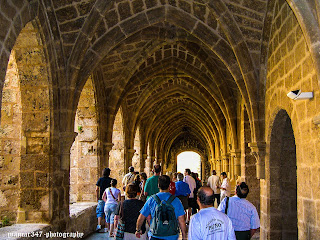Piedra: un patrimonio malherido / Piedra: a badly wounded heritage
El de Piedra, como tantos otros grandes monasterios levantados
por benedictinos y cistercienses, tanto dentro como fuera de esa red ortoténica
de singulares caminos sagrados, que, uniéndose, principalmente, en la notable localidad
navarra de Puente la Reina, se dirigen a Compostela, es otro ejemplo
desgraciado de cómo las ‘homines iraes’ o las iras de los hombres, se cebaron,
con toda la fuerza de su intrínseco poder de destrucción, sobre un Patrimonio,
Histórico, Artístico y Cultural, que, paradójicamente y en no pocas ocasiones,
significaron la comparativa y metafórica ‘barra libre’ para un abyecto mercado subterráneo,
donde el expolio, el robo descarado de nuestros tesoros artísticos, la
ignorancia y de la dejadez gubernamental, permitieron el exilio de objetos y
piezas insustituibles, que hoy en día brillan con todo su esplendor en tierras
extranjeras.
En Piedra, esto se hace mucho más evidente, cuando, dejando
atrás un claustro, que, afortunada y milagrosamente, todavía conserva buena
parte de su belleza original, el visitante, curioso, accede al recinto donde
antaño se levantaba una de las iglesias más monumentales del Arte Sacro en Aragón
y contempla, desolado, el paso apocalíptico de un vendaval homicida de
proporciones catastróficas, que reflejan, inequívocamente, el paso de un
tsunami arrollador, que se cebó sobre una pieza clave de nuestra herencia
cultural.
Poco reconocibles son, en la actualidad, esos descarnados muñones, donde antaño, estilos arquitectónicos, como el románico y el gótico, tendían amistosamente la mano a otras evoluciones, como el renacentista y el barroco, cuyo patrón, a fin de cuentas, era albergar, en esa maravillosa y metafórica cajita de resonancia, el canto universal de un espíritu, que, si no capaz de mover montañas, sí al menos, de transformar canteras en el lenguaje del universo: la Geometría Sagrada.
That of
Piedra, like so many other great monasteries built by Benedictines and
Cistercians, both inside and outside that orthothenic network of singular
sacred paths, which, uniting mainly in the notable Navarrese town of Puente la
Reina, head to Compostela, is another unfortunate example of how the 'homines
iraes' or the anger of men, fell, with all the force of their intrinsic power
of destruction, on a Historical, Artistic and Cultural Heritage, which,
paradoxically and on many occasions, they meant the comparative and
metaphorical 'open bar' for an abject underground market, where looting, the
blatant theft of our artistic treasures, ignorance and government neglect,
allowed the exile of irreplaceable objects and pieces, which today shine with
all its splendor in foreign lands.
Little
recognizable today are those stark stumps, where once upon a time,
architectural styles, such as the Romanesque and the Gothic, extended their
hand amicably to other evolutions, such as the Renaissance and the Baroque,
whose pattern, after all, was to house , in that wonderful and metaphorical
little resonance box, the universal song of a spirit, which, if not capable of
moving mountains, is at least capable of transforming quarries into the
language of the universe: Sacred Geometry.
AVISO: Tanto el texto, como las fotografías que lo acompañan,
son de mi exclusiva propiedad intelectual y por lo tanto, están sujetos a mis Derechos
de Autor.
NOTICE:
Both the text and the accompanying photographs are my exclusive intellectual
property and are therefore subject to my Copyright.











Comentarios